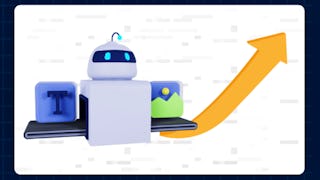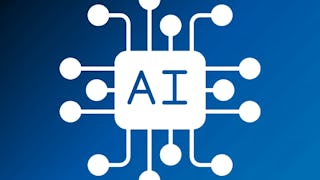What Is a Project Scope and Why Does It Matter?
October 30, 2024
Article



Recommended experience
Beginner level
Some experience with using generative AI (have tried using a chatbot, for example)
Recommended experience
Beginner level
Some experience with using generative AI (have tried using a chatbot, for example)
Trace the evolution of AI from its early concepts to modern generative model
Identify key technological breakthroughs that enabled the rise of generative AI

Add to your LinkedIn profile
2 assignments


Add this credential to your LinkedIn profile, resume, or CV
Share it on social media and in your performance review

Dive into the fascinating journey of artificial intelligence, from its theoretical beginnings to today's powerful generative models. This course offers a unique perspective on how AI has transformed over decades, highlighting the crucial developments in deep learning that paved the way for modern AI breakthroughs.
After completing this course, you will be able to: - Trace the evolution of AI from its early concepts to modern generative models - Identify key technological breakthroughs that enabled the rise of generative AI - Understand the fundamental differences between traditional AI and generative AI - Recognize potential applications and impacts of generative AI across various fields You'll gain insights into the game-changing advancements—like self-supervised learning and transformers—that propelled generative AI to its current prominence. By understanding this history, you'll be better equipped to anticipate future trends and applications in AI. Whether you're an AI enthusiast, a professional looking to leverage AI in your field, or simply curious about the technology shaping our future, this course provides valuable context to help you navigate the exciting world of generative AI.
Meet the instructor, Prof. Jesse Spencer-Smith, and find out about how we'll learn the history of AI and gain insight into the future.
1 video1 reading
Let's take a trip through time and look at how AI has changed over the years. You might be surprised to learn that we've been talking about "AI" for over 60 years! But here's the funny thing - what we've called AI has changed drastically. In this lesson, we're going to explore the journey from the very first discussions about machine intelligence all the way to the chat assistants we have today. We'll look at the key players, the breakthrough moments, and the times when AI hit roadblocks. You'll see how the goals and approaches of AI shifted, even though we kept using the same term. Understanding this history isn't just about looking back - it's crucial for grasping why today's generative AI is such a big deal. So buckle up - we're about to dive into the fascinating story of how we got from early computers to machines that can chat, create, and reason.
2 videos
In this lesson, we're going to explore why generative AI represents such a significant leap forward in the field of artificial intelligence. We've been working on AI for decades, but recent developments have led to breakthroughs that were once thought to be years away. We'll examine the key advancements that have enabled this shift: a powerful new learning algorithm, the innovative approach of self-supervised learning, and the impact of scaling up our models. These elements have come together to create AI systems capable of tasks that were previously considered extremely challenging or even impossible. By understanding these core developments, you'll gain insight into why generative AI has become so prevalent and powerful. We'll discuss how these changes have resulted in AI that can generate human-like text, create art, and even write code. By the end of this lesson, you'll have a clear understanding of what sets generative AI apart and why it represents a fundamental shift in artificial intelligence capabilities. Let's dive into the technologies that are driving this AI revolution. CopyRetryClaude can make mistakes. Please double-check responses.
2 videos
In this final lesson, we explore the cutting edge of generative AI and peek into its future. We'll examine the architecture of decoder transformers - the engines powering today's most advanced AI models - and uncover how relatively small changes in training can lead to dramatically different capabilities. You'll learn about the latest developments like instruction fine-tuning and AI agents, and understand why smaller, more efficient models are on the horizon. We'll also discuss the profound implications of generative AI for businesses and individuals, including the concept of "opportunity liability" and the democratization of technical skills. By the end of this lesson, you'll have a clear picture of generative AI's trajectory and be well-equipped to anticipate and leverage future developments in this rapidly evolving field.
2 videos2 assignments



Vanderbilt University, located in Nashville, Tenn., is a private research university and medical center offering a full-range of undergraduate, graduate and professional degrees.

Board Infinity
Course

Amazon Web Services
Course

Edureka
Course

Duke University
Course





Unlimited access to 10,000+ world-class courses, hands-on projects, and job-ready certificate programs - all included in your subscription
Earn a degree from world-class universities - 100% online
Upskill your employees to excel in the digital economy
Access to lectures and assignments depends on your type of enrollment. If you take a course in audit mode, you will be able to see most course materials for free. To access graded assignments and to earn a Certificate, you will need to purchase the Certificate experience, during or after your audit. If you don't see the audit option:
The course may not offer an audit option. You can try a Free Trial instead, or apply for Financial Aid.
The course may offer 'Full Course, No Certificate' instead. This option lets you see all course materials, submit required assessments, and get a final grade. This also means that you will not be able to purchase a Certificate experience.
When you purchase a Certificate you get access to all course materials, including graded assignments. Upon completing the course, your electronic Certificate will be added to your Accomplishments page - from there, you can print your Certificate or add it to your LinkedIn profile. If you only want to read and view the course content, you can audit the course for free.
You will be eligible for a full refund until two weeks after your payment date, or (for courses that have just launched) until two weeks after the first session of the course begins, whichever is later. You cannot receive a refund once you’ve earned a Course Certificate, even if you complete the course within the two-week refund period. See our full refund policy.
Yes. In select learning programs, you can apply for financial aid or a scholarship if you can’t afford the enrollment fee. If fin aid or scholarship is available for your learning program selection, you’ll find a link to apply on the description page.
Financial aid available,
Learn on your own time from top universities and businesses.
Already on Coursera?
I accept Coursera's Terms of Use and Privacy Notice. Having trouble logging in? Learner help center
This site is protected by reCAPTCHA Enterprise and the Google Privacy Policy and Terms of Service apply.